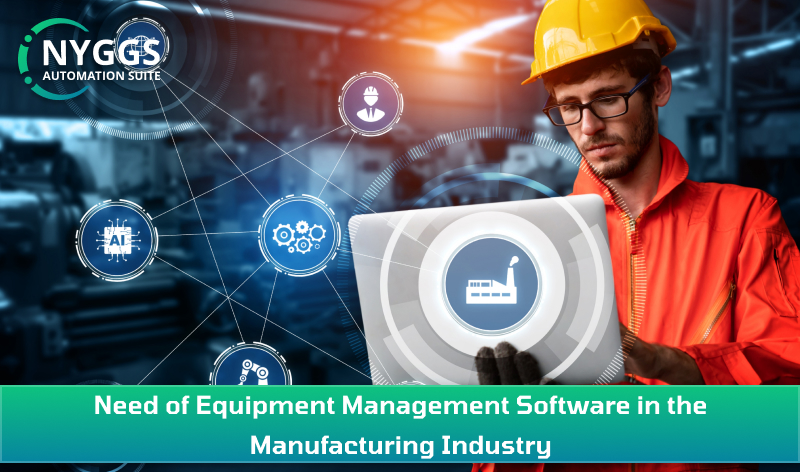The manufacturing industry relies heavily on equipment and machinery to produce goods and meet customer demands. And for maintaining that, they demand a solution that helps them organize their needs. That’s where the use of Equipment Management Software stands out. The primary purpose of the software is to reduce costly breakdowns by ensuring that machinery works at its best.
Nevertheless, some manufacturers still question the need for Equipment Management System. So, in this blog, we will discuss the need for Equipment Management Software. Here are some key reasons why the manufacturing industry should invest in this:
Asset Tracking and Visibility
To streamline the process, you must have a platform that lets you easily track Equipment status. A centralized platform to monitor all Equipment within the manufacturing industry makes the process easy. And for that, you require Equipment Management Software. It creates a common platform to upload all the required data.
You can easily maintain asset details, location, availability, and maintenance history with software. It improves the visibility into the status and utilization of equipment. Therefore, it promotes organization towards better planning and decision-making.
Preventive Maintenance
Why would a manufacturing company risk unplanned downtime when expenses are so high? And the risk is increased when timely maintenance is not planned. Equipment Management System schedule and manage preventive maintenance tasks. It facilitates the creation of maintenance schedules to track maintenance activities.
The software also sends alerts for upcoming overdue tasks. This proactive approach reduces the chance of equipment failures. Moreover, it extends asset life and enhances overall operational reliability. Timely maintenance is a must for reducing unplanned downtime. The software helps in Scheduling and Tracking maintenance activities.
Work Order Management
You can automate the work order management process by creating and tracking maintenance tasks. It enables technicians to receive work orders electronically. Additionally, it provides access to relevant equipment information and maintenance procedures.
Moreover, the software also allows real-time data updates on task status. This improves communication and reduces manual paperwork. Thus, it ensures the timely completion of maintenance activities.
Inventory Control
Effective management of spare parts and inventory is crucial in the manufacturing industry. So, Equipment Management helps manufacturers maintain accurate records. It tracks spare part usage and automates reordering processes. The software provides real-time visibility into inventory levels, locations, and use. It ensures precise inventory records and minimizes stockouts or excess inventory.
Therefore, manufacturers can improve Equipment uptime and reduce production delays by maintaining optimal inventory levels. Inventory Management functionality also enables automated reordering and inventory reconciliation. It streamlines the procurement processes of the product. This integrated approach ensures the availability of the necessary part. Additionally, supplies support equipment maintenance activities.
Data Analytics
Having the asset’s data and analytics is necessary for improving performance. The Equipment Management Software includes that feature. The software shows the overall analysis of the assets related to maintenance. You can calculate the expected performance and optimize asset performance with an accurate analysis.
Analyzing trends and optimizing asset health is essential for maintaining growth in any business. With the help of the software, you can get data that quickly indicates assets’ health. By this, you can easily recognize which equipment needs maintenance or change. Therefore, this helps in maintaining smooth functionality within the industry.
Which Type of Equipment Management Software Is Best for the Small-Size Manufacturing Industry?
If you own a small manufacturing industry, you know how hectic managing all tasks can be. Managing the workforce and machines and handling vendors is all in your hands. So, to give you relief, Equipment Management System is designed. But, it is essential to have software specially tailored for your business and fit your pocket.
Here are some of the points you may consider before finalizing the software:
User-friendly Interface
Look for software with an intuitive and user-friendly interface. Small-size manufacturers may have limited IT resources, so a software solution that is easy to learn and navigate can ensure smoother implementation and usage.
Scalability
Always consider software that can accommodate the growth of your business. This software should be flexible enough to handle increasing equipment needs. It would help if you also managed your increasing inventory demands as your business expands.
Essential Features
Identify the key features crucial for your equipment management needs. This may include equipment tracking, maintenance scheduling, work order management, and reporting capabilities. Focus on finding a software solution that covers these essential functionalities.
Cost-Effective Solution
Considering the affordability of the Equipment Management Software is also crucial. It includes upfront costs, licensing fees, and ongoing maintenance expenses. Look for solutions that offer competitive pricing options, such as subscription-based models or cloud-based solutions. It eliminates the need for costly infrastructure.
Vendor Support
Choose reputable software that provides reliable customer support and regular software updates. This can be particularly important for small-size manufacturers with limited IT expertise. Vendor support can help address technical issues or guide implementation and usage.
Industry-Specific Solutions
Try to be industry specific. Choose the Equipment Management Software that is specially tailored for manufacturing. These solutions often have preconfigured templates, workflows, and reports tailored to manufacturing operations. It makes it easier to implement and adapt to your unique requirements.
Conclusion
Before making a purchase, a thorough understanding of the product is essential. If you know your weaknesses, the Equipment Management Software can simplify your job. Numerous functions can be found in any software, but only you can determine what ones you need. In addition, small businesses with limited resources must have a solution that suits their requirements.
Therefore, you can make many administrative tasks more accessible by implementing Equipment Management System. And we have discussed all the features in detail in the hope that this will guide you in making an informed choice.


